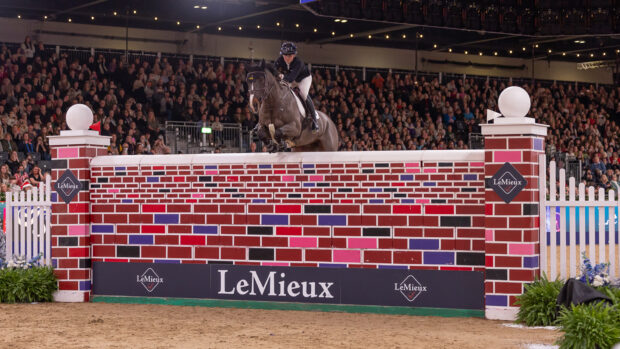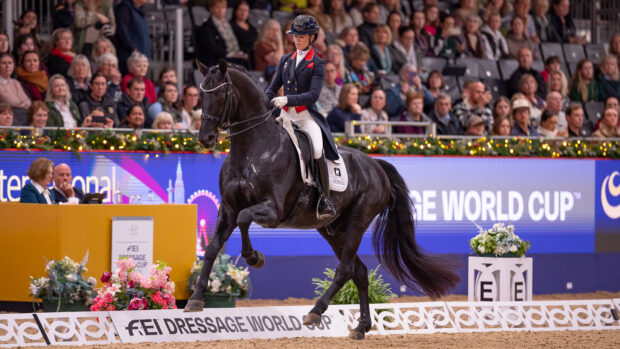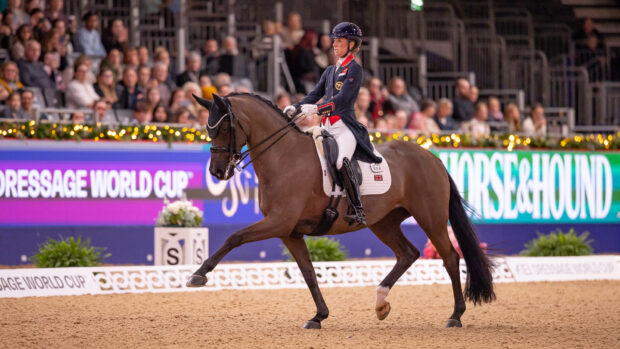THE removal of Horse of the Year Show (HOYS) qualifiers from the Great Yorkshire Show (GYS) has sparked debate across the industry.
HOYS took some pony qualifiers from the GYS as the latter would not revoke its rider-age rule, by which ponies can only be ridden, anywhere on the showground by either the competitor, or another rider who is of the appropriate age for the class concerned.
H&H gathers views from across showing.
Julie Templeton: apply rules across the board
TOP show pony producer Julie Templeton believes riders’ size and weight should be key, rather than age, as she said in her recent H&H column.
She told H&H she believes those on all sides of the debate are on the same page, with horse and pony welfare “at the heart of all we do”.
She believes it was not fair for the GYS to lose its HOYS qualifiers, but thinks rules on rider size should apply across the board.
“My only concern with the GYS rule – and I think it’s appropriate the right-sized people ride the right-sized ponies – is that it should apply to all classes, not just target the plaited ponies,” she said.
“If you’re going to bring these things in, and with all the talk about social licence, we’ve got to protect our horses, their welfare and our industry. I wish it had been across the board.”
Julie pointed out that a 5ft 3in, lightweight adult cannot work in a 128cm show pony at the GYS, but a 5ft 10in lightweight adult could compete a Dartmoor pony.
“I don’t want to lose anyone their livelihood, and appreciate there’s a place for small adults working a pony in to give it confidence and set it up so the child has a positive experience,” she said. “Some of our children sadly only ride in the show ring, and it’s important they’re on ponies who understand and are straight, obedient, soft in the mouth and comfortable to ride.
“And we’ve got to be inclusive, for the children who may not have the facilities to ride at home; we want to encourage children from all backgrounds to enjoy riding.”
Julie also pointed out the exciting atmosphere at major county shows and that the classes concerned do not specify that they are looking for the safest ponies.
“There are lots of ponies for people to learn on at different levels,” she said. “One is the riding school pony, and if you want to change a show pony to a riding school one, that’s fine, let’s have a class for that. But at the moment, it’s for the best pony and the best pony might be a bit sharper and trickier.
“For it to be a positive experience, we want to help and support children until they’re confident to work the ponies in and haven’t left the industry because they’ve fallen off too many times.
“I completely understand the GYS rule, and they can put in place whatever rules they want, and it’s then a choice. You say to clients, ‘Let’s go there and have a lovely time,’ or ‘Actually, your pony might not fit in that environment.’ My overriding priority is the child’s safety and that they have a positive experience, so if we have a pony we think won’t cope, we’ll be honest with the client.
“They’re not robots and machines and we don’t want them to be – and one concern if you ban things is, what will then go on at home?”
Jill Perkins: wellbeing comes first
SHOWING would “find itself in hot water” if what went on in some lorry parks was lightlighted, a former British Show Pony Society (BSPS) judge believes.
Jill Perkins officiated at major shows in the UK and around the world.
“A child’s pony should be both beautiful and suitable,” she told H&H. “I would always look for a pony that was correct, a free-moving pony with perfect manners and really importantly, appears happy doing its job.
“As a judge, there was nothing worse than seeing a pony that had obviously been set up by an older rider. It does not present a pretty picture and it certainly doesn’t look natural when the child is just passenger rather than pilot, which is sadly too often the case.
“Now there is so much more information available, surely the physical and mental wellbeing of the ponies must come first. The relationship between pony and rider cannot be artificially created; a good judge should be able to recognise the true partnership.
“If your pony is set up by someone else and you are just plonked on board for the show ring, there is no real connection and frankly what is the point? You only have to consider the number of children who grew up riding show ponies and yet, possibly because of the pressured environment, they no longer ride as adults.”
Ms Perkins referenced the recent Showing Council webinar on social licence adding: “If a reporter or anyone chose to actually highlight what goes on in the lorry parks at most shows, I’m sorry to say showing would be find itself in hot water.
“We need to continue to do more to improve standards, and there are many other methods that can be used if we choose to open our minds and consider moving away from some of the outdated traditional ways – or maybe something as simple as more turnout, which was always good to settle an animal. Animal welfare should always be the top priority.”
Ms Perkins added that she believes the breeding of children’s showing ponies could be affecting the issue.
“Maybe we should be returning to breeding with a little more native blood?” she said. “Growing up, our ponies weren’t too hot for us to ride and if we came off a few times, then we were just put back on and tried harder. It taught us to ride and how to care and respect our ponies – often being told it’s an animal, not a machine! Or is it the way some are produced that means they need riding by bigger jockeys before they are considered safe for a child?
“Welfare needs to be considered right from the early days, including environment, handling and everything that forms the character of the animal.”
Paul Cook: properly prepared
BSPS chairman Paul Cook believes showing needs to be inclusive, and to ensure young jockeys have a positive experience, while horse welfare and rider safety are top priority.
Mr Cook told H&H that the BSPS “absolutely supports” the GYS on its size and weight rules, but does not agree with the rider-age rule.
“I think there are several parts to this,” he said. “We’re lucky in this country to have some beautiful, quality show ponies and show hunter ponies, and they need to be properly trained and the jockeys properly prepared.
“These classes cater for children from three years old – shows can be excitable places – and we’re talking about really quality, elite ponies. Some of the younger children need help working them in, and I think if the person riding the pony is suitably mounted, doing it correctly and supporting the child, that’s reasonable.”
Mr Cook said the BSPS has a clear welfare policy in its rule book, and there are stewards and judges to whom any welfare-related concerns can be reported at shows. He added that one consequence of the rider-age rule could be that it affected a child riding a 128cm pony in one class and a 138cm in the next who, with no one else to ride, would not be able to work the second pony in.
He said some producers might have horses in multiple classes and need someone else to warm up, so there is widespread precedent for working in under different riders. He pointed out that in (M&M) classes with no age limit, adults can ride ponies in the class and beforehand, but might not be able to work in the same ponies if they were entered in a first ridden class, for example.
“When we’ve got young children, we want to encourage them into the sport and make sure they have a positive experience,” he said, adding that although the ponies should be well-mannered in the ring, this is a big atmosphere, for which they should be properly prepared.
“We’ve got to think what’s right to give the child the right amount of confidence to enjoy their showing, on what are quality ponies. Saying a tiny tot has to do everything with their pony doesn’t seem to me the best way forward.
“We want children to go in the ring with the best chance of doing their best, with the ponies supporting them, and I’m not sure this rule allows that. There are plenty of rules to prevent people working ponies in when they’re unsuitably mounted, and I think it would be more helpful, if shows wanted to bring rules in like this, if there was consultation.
“I think there are better ways of educating people about doing the right thing than rules brought in with unforeseen consequences.
“I think we’re all on the same page – that horse welfare and rider safety are paramount and where children are concerned, we want them to really enjoy the sport.”
Amanda Stoddart-West: suitable for the job
THE welfare of horses and ponies in showing must be “greatly elevated” if the sport is to continue in the long term.
This is the view of Amanda Stoddart-West, entries and livestock coordinator of the GYS, which has been the first to introduce a number of welfare-related rules.
“Regardless of whether you feel the pony is a true child’s pony or not, seeing a pony forced to carry a rider that is far too heavy for that animal is not acceptable; we should be promoting the welfare of all animals, not accepting that a pony needs riding by a bigger person simply because it’s too hot for the job,” she told H&H. “Although the safety of children is obviously important, this should not under any circumstances be at the expense of the welfare of the pony; if a pony needs to be ridden by a larger, more experienced rider, maybe it’s just not suitable for that job.”
In response to the opinion that the classes are not titled “safest pony”, Mrs Stoddart-West countered that they do state “suitable for a child”.
“Or are children’s riding pony classes not really for children’s ponies and if not, why not?” she asked. “If this means potentially changing the dynamic, then wouldn’t this be a good thing? As well as the welfare aspect, at what point do we consider this from a fairness perspective, as surely a level playing field in all sport should be encouraged.”
Mrs Stoddart-West added that, as a child who grew up riding and looking after her own ponies, “I wonder how a child bonds, builds that trust or forms a relationship with a pony, if someone else does all the work?
“How does this encourage young riders to remain interested in showing? In hardly any other equestrian discipline do you see someone else riding the animal in before the class or competition.”
Mrs Stoddart-West also works in her spare time to improve welfare standards.
“Over the last few years, we have received photos, videos and reports from across the country from friends, exhibitors, judges, stewards and concerned bystanders,” she said.
“A few examples are photos of riders who are clearly far too big for their mounts, a video of a judge on a 12.2hh pony that is obviously struggling to carry him and ponies tied up really short overnight without hay or water, or being blindfolded until they enter the ring.
“The showing fraternity really needs to take things seriously, not only owing to social licence.
“In my opinion, the welfare of horses and ponies has to be greatly elevated within the showing sector, if we want to see riding and showing to continue in the long term.”
You might also be interested in:

‘It’s about equine welfare, not flattening ponies’: show speaks out on its rider-weight stance

Julie Templeton: ‘Riders’ size and weight must be key, not their age’

Five years on, show’s rider size policy is making change

Subscribe to Horse & Hound magazine today – and enjoy unlimited website access all year round
Horse & Hound magazine, out every Thursday, is packed with all the latest news and reports, as well as interviews, specials, nostalgia, vet and training advice. Find how you can enjoy the magazine delivered to your door every week, plus options to upgrade your subscription to access our online service that brings you breaking news and reports as well as other benefits.



